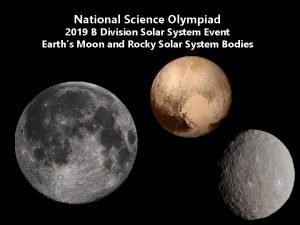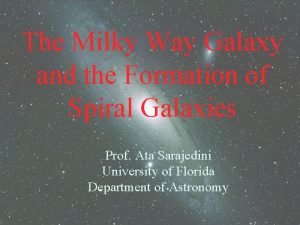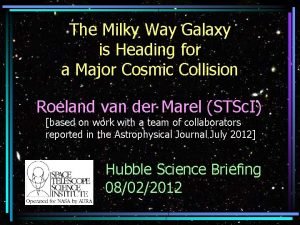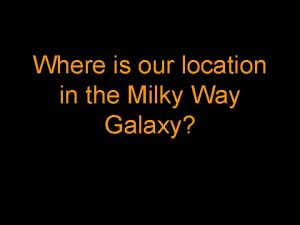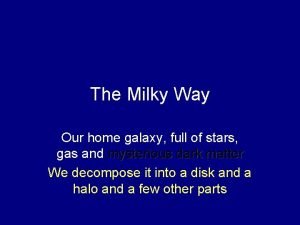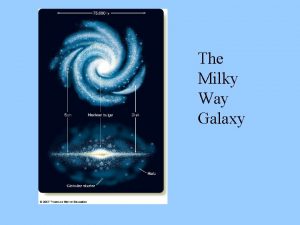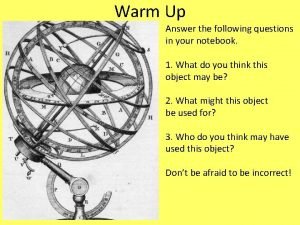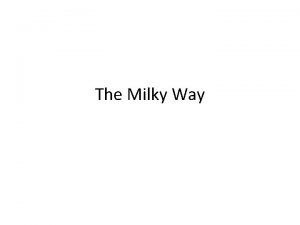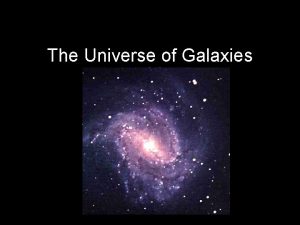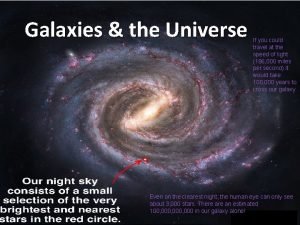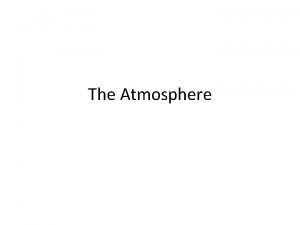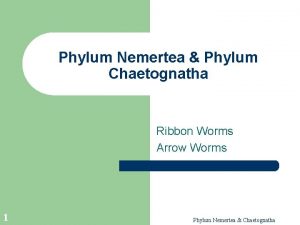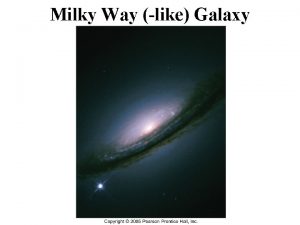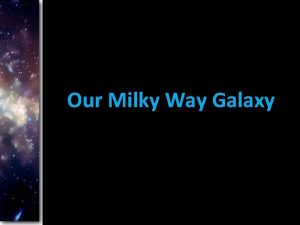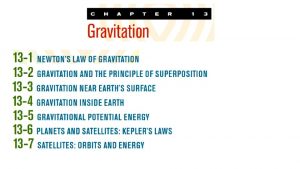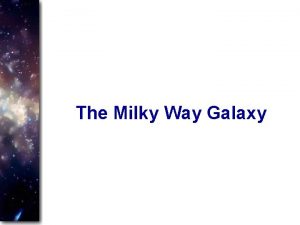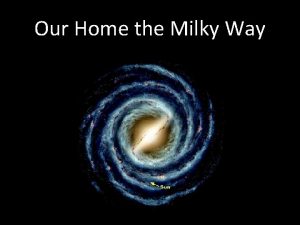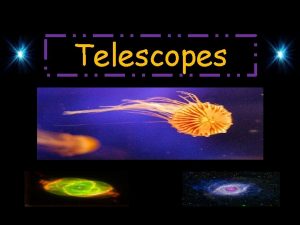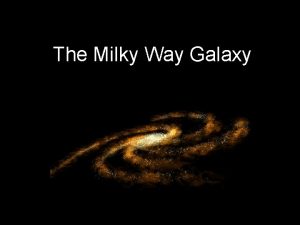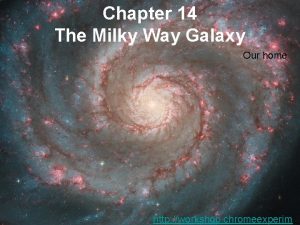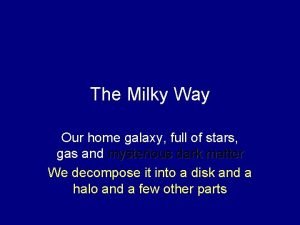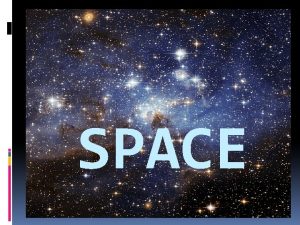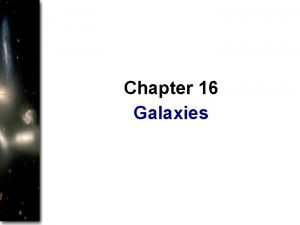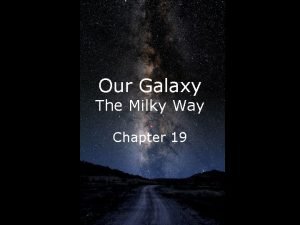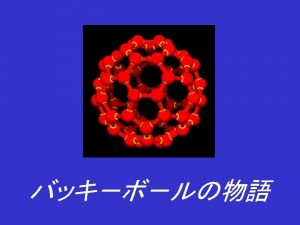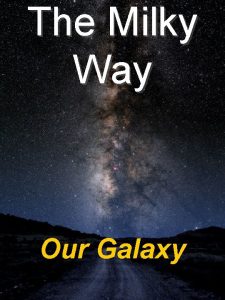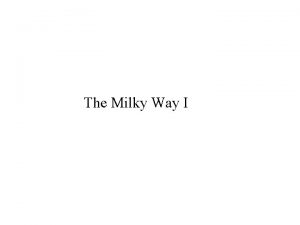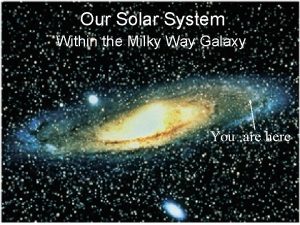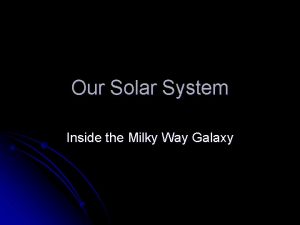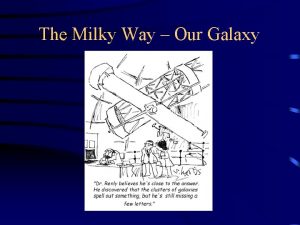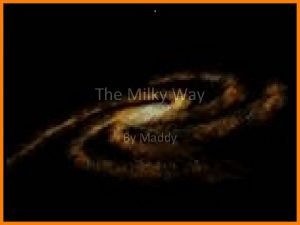Summary for the Milky Way Our home galaxy
































- Slides: 32

Summary for the Milky Way Our home galaxy is a spiral type. An overview of components are presented in terms of global properties, structural arrangement, and contents. The latter serves to unify the ISM and stellar components. Additionally, important new components are identified: the mysterious dark matter permeating the Milky Way, and central supermassive black hole. Additionally, the concept of elemental abundances as a tool for inferring information about the formation and development of the Milky Way is introduced.

The Milky Way Galaxy

Sky Maps in Different Bands

The Milky Way: Historical Prelude v William Herschel (1785) – shape of MW from counting stars; region of more stars implies greater extent v Jacobus Kapteyn (~1900) – similar result as Herschel Both Herschel and Kapteyn inferred MW to be a flat disk, but incorrectly placed Sun near center. They did not know about extinction!

Hershel’s Map

Living on the Inside

Locating the Galactic Center Harlow Shapley (1915) – Identified RR Lyraes in globular clusters, so he measured their distances He noted that globulars tended to be in one part of the sky He thus located the MW center in a “mobile” deprojection style approach.

Milky Way Components • Disk – contains most of gas and stars • Nucleus – central region of MW, likely with approximately a 106 Mo black hole at center • Bulge – roughly spherical region of stars around nucleus • Halo – extended spherical region with globular clusters, old stars, and “dark matter”

Anatomy of the Milky Way

Milky Way Properties • • • Diameter of Disk: Diameter of Halo: Diameter of Bulge: Location of Sun: Mass of MW: – – ~ 40 kpc ~ 70 kpc (? ) ~ 6 kpc ~ 8. 5 kpc from center of disk Total ~ 1012 Mo Gas ~ 1010 Mo Stars ~ 1011 Mo Dark Matter ~ 1012 Mo

Stellar Populations in the MW • Pop. I – Stars in disk – Orbits lie in disk – Stars have trace metals • Pop. II – Stars in halo – Orbits are “random” about Galactic Center (GC) – Extremely trace metals


Milky Way Formation

Spiral Arms • O & B stars form where there is gas and live short lives. • Distances reveal that these stars group along “segments”, suggesting spiral arms • Radio measurements have mapped out the spiral structure in H-gas • The arms are a “pattern”, where MW matter moves slow inside arms and fast inbetween

The Process of Radio 21 cm Radiation

Radio Mapping the MW Arms

Mapping Example

The Arms: Radio Guide

Example use of 21 cm mapping in other galaxies to trace their HI cl

The Arms: The Winding-Up Problem Spiral arms result from how stars congregate in spiral patterns. For a galaxy of 10 Gyr age, with a rotation period of around 0. 25 Gyr at the Sun, spirals should have many tight wrappings of the arms if stars are constrained always to reside within the arms. But how else could it be?

Spiral Arms as a Pattern A pattern of slow traffic migrates down the road at the speed of the truck. This “knot” of traffic is always present, even though it consists of different cars at different times.

Spiral Pattern Models Computer simulation for how stars orbit around a galaxy. Spiral patterns are a natural outcome.

The Galactic Rotation Curve • Sun, stars, and gas orbit around MW center in a disk, obeying Kepler’s 3 rd Law, • Know r. Sun = 8. 5 kpc, vrot(Sun) = 220 km/s, so that mass interior to the Sun’s orbit is ~ 1011 Mo [Note, vrot ~ 46 AU/yr or 1 circuit every ~108 yrs]

Example Rotation Curves

Milky Way Rotation Curve

The Dark Matter • Can construct a rotation curve by using other “markers” – stars and clouds • Observe a “flat” rotation curve with vrot=constant • But this implies that M ~ r ! Where does it end? • At MW edge, expect to see • Estimates set MMW ~ 1012 Mo, 10 x more than observed luminous matter • Hence 90% of our Galaxy remains “unseen” and mysterious

Dark Matter Candidates Remains unclear 1. Old WDs 2. Brown Dwarfs 3. Planets 4. BHs 5. Neutrinos 6. H 2 gas clouds 7. Modified gravity

The Galactic Center • Cannot “see” in visible light, so must study in other bands (X-ray, IR, radio) • Crowded with stars • At very center is a large rotating ring of gas, with about 104 Mo, stretching from r=2 pc to r=8 pc, rotating at 110 km/s, implying 107 Mo of matter interior to 2 pcs • Difficult to cram so much matter in so little space!

Galactic Center from Chandra Different colors for different energies of the X-ray photons

Radio Maps of the Galactic Center: The bright spot in the center is Sgr*, the center of our Galaxy

Orbits of Stars at MW Center: (More evidence for a massive BH)

The Central Black Hole • Strong suggestion of a super-massive BH (SBH) of M ~ 107 Mo, with RS ~ 0. 2 AU • Main evidence from a compact (13 AU in size) and bright radio source at Sgr A* • Possibly an accretion disk of gas that feeds the SBH
 Classification
Classification Milky way galaxy
Milky way galaxy Closest galaxy to milky way
Closest galaxy to milky way Milky way galaxy sketch
Milky way galaxy sketch Critical density
Critical density Our location in the milky way
Our location in the milky way Our home galaxy
Our home galaxy Our home galaxy
Our home galaxy Milky way description
Milky way description Where is the solar system located in the milky way
Where is the solar system located in the milky way Democritus milky way
Democritus milky way Dung beetle milky way
Dung beetle milky way The milky way
The milky way Myfonterra
Myfonterra Jupiler
Jupiler Lime water milky
Lime water milky Zjezd
Zjezd Nemertea diagram
Nemertea diagram Milky appearance of plasma
Milky appearance of plasma Pengertian home care
Pengertian home care Perbedaan home care dan home visit
Perbedaan home care dan home visit Mobile home parks for sale in sc
Mobile home parks for sale in sc Flower plural
Flower plural Softly and tenderly jesus is calling
Softly and tenderly jesus is calling Oak springs mobile home park
Oak springs mobile home park Let's go to my house
Let's go to my house André fougeron
André fougeron She said that, home economics stands for the ideal home.
She said that, home economics stands for the ideal home. Home sweet home survive items
Home sweet home survive items The earth is our home i promise to keep it
The earth is our home i promise to keep it “the world is our home” is an example of
“the world is our home” is an example of Slow way home
Slow way home Slow way home
Slow way home

